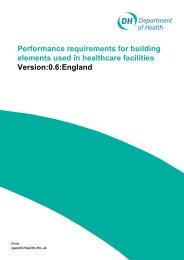Early Life Nutrition and Lifelong Health - Derbyshire Local Medical ...
Early Life Nutrition and Lifelong Health - Derbyshire Local Medical ...
Early Life Nutrition and Lifelong Health - Derbyshire Local Medical ...
Create successful ePaper yourself
Turn your PDF publications into a flip-book with our unique Google optimized e-Paper software.
BMA Board of Sciencethe mothers were willing to breastfeed exclusively for at least four months continuing until12 months, <strong>and</strong> to introduce complementary feeds by six months; <strong>and</strong> none were smokers. Thedata were collected using st<strong>and</strong>ardised techniques in the USA, Oman, Norway, Brazil, Ghana <strong>and</strong>India in 1997-2003. One concern about the generalisability of these st<strong>and</strong>ards is the wideinternational variation in birth weight. Mean maternal height <strong>and</strong> birth weight in Oman <strong>and</strong> Indiawere much lower than in Norway <strong>and</strong> the USA, indicating maternal constraint on fetal growth inthese developing countries, which is also likely to be associated with effects on postnatal growth,inducing more rapid catch-up growth. 172Box 9: Comment on the WHO infant growth reference st<strong>and</strong>ard‘The most interesting thing about the study that gave rise to these st<strong>and</strong>ards is that despitebeing based on very diverse populations around the globe, they produced very similar growthcurves, indicating that genetics plays a very small part in determining growth rates comparedwith environmental factors which were optimised for this study – healthy pregnancy, goodmother <strong>and</strong> child nutrition, no smoking, full breastfeeding etc.’Tim Lobstein, Director Childhood Obesity Research ProgrammeA joint expert group from SACN <strong>and</strong> the Royal College of Paediatrics <strong>and</strong> Child Heath (RCPCH)met to consider the routine use of the WHO st<strong>and</strong>ards in the UK. 172 They concluded that UKinfants would appear large at birth <strong>and</strong> show apparent marked catch-down growth during the firstfew weeks, which could discourage mothers from breastfeeding. Using the WHO st<strong>and</strong>ards would,however, reduce the number of UK infants showing weight faltering, <strong>and</strong> thus being classified asunderweight, after four months. They found little difference in length between the UK 1990 <strong>and</strong>WHO references at any age, <strong>and</strong> there was convergence of weight in the two references fromaround two years onwards. The group advised adoption of the WHO Growth St<strong>and</strong>ard for routineuse from two weeks to 24 months, while retaining the UK 1990 reference from 24 monthsonwards. Since the WHO reference population did not include pre-term infants, the UK 1990reference would also need to be retained for these infants. They recommended piloting of the newcharts, training for health professionals, <strong>and</strong> a well-planned communications strategy precedingimplementation. It is not clear when all this will happen, but it is unlikely that the st<strong>and</strong>ard will bein general use before 2009.Key messageInfant growth-charts currently in general use in the UK (based on 1990 UK reference data) arenow considered inadequate because weight gain patterns of breastfed infants deviateconsiderably from such data. Old growth charts should be replaced by the 2006 WHO newgrowth reference – based exclusively on breastfed babies – for assessing all infants agedbetween two weeks <strong>and</strong> 24 months.<strong>Early</strong> life nutrition <strong>and</strong> lifelong health 39



